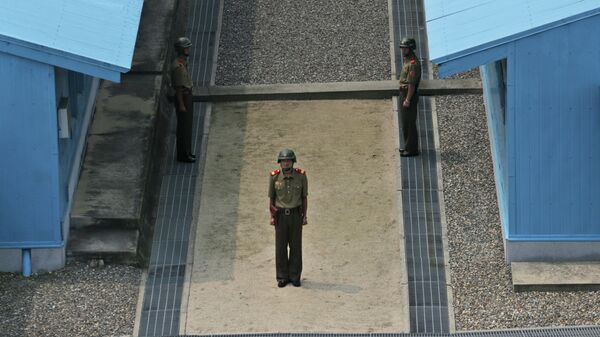MOSCOW (Sputnik) — The incident marks the first serious escalation of the long-standing conflict in recent years.
Roots Go Back to 1945
The roots of the lingering tension on the Korean Peninsula go back to 1945 and the end of the Second World War.
Until 1945, Korea was part of the Empire of Japan as a Governorate General. In August 1945, when the Red Army accepted the surrender of Japan’s Kwantung Army, the northern part of the Korean peninsula was liberated. Two temporary zones were established in Korea by the anti-Nazi allies for managing the surrender of the Japanese army: the Soviet zone to the north of the 38th parallel and the US zone to the south of the line. US troops landed in the south of the country in September 1945.
In 1947, at the initiative of the United States, the issue of creating a single state on the Korean Peninsula was referred to the United Nations, which decided to hold elections supervised by UN Commission. In May 1948, parliamentary elections were held in South Korea, and the Republic of Korea (South Korea) was proclaimed on August 15.
Meanwhile, elections to the Supreme People’s Assembly were held in the north, and the Democratic People’s Republic of Korea (DPRK) was established on September 9, 1948.
Military, Political Tensions Result in War
Military and political contradictions between the two countries, with their different social and political regimes, resulted in the outbreak of war in the early 1950s.
The conflict broke out on June 25, 1950, between US Armed Forces, along with 15 other countries under the banner of a UN multinational force fighting for South Korea, and the DPRK, backed by Chinese and Soviet troops.
The front line stabilized by July 1951 at the 38th parallel, the same place where hostilities began, and the conflict evolved into a positional war. By the spring of 1953, it was clear that victory would come at too high a price for any of the parties, paving the way to the signing of an armistice agreement in Panmunjom on July 27, 1953.
Armistice and Establishing Demilitarized Zone
The armistice, while not an official peace between North Korea and South Korea, established a demarcation line with a four-kilometer-wide demilitarized zone on both sides.
The two powers on the Korean Peninsula are still technically in a state of war, since the Korean War ended with an armistice, not a peace treaty. The armistice was signed by DPRK and Chinese army commanders on the one side, and the United States under the UN banner on the other.
The United States has refused to sign a peace treaty with North Korea and kept about 28,000 troops in the south of the Korean Peninsula.
In July 1972, the North-South Joint Statement was signed, outlining the main principles of reunification: independently, without reliance on foreign powers; peacefully, and based on a "great ethnic consolidation." For Pyongyang, reunification would be implemented by creating a confederation (Confederative Democratic Republic of Korea) following the formula, "one nation, one state – two systems, two governments."
In 1991, the DPRK and South Korea signed an Agreement on Reconciliation, Non-Aggression, Exchange and Cooperation, and went on to adopt a Joint Declaration on Denuclearization of the Korean Peninsula.
Two Inter-Korean Summits were held during these years, both hosted by Pyongyang: June 13-15, 2000, between former DPRK leader Kim Jong-il and then-President of South Korean Kim Dae Jung; and October 2-4, 2007, between Kim Jong-il and Roh Moo-hyun, who was serving as South Korea’s President at that time.
Relations Between South, North Koreas Begin to Deteriorate
When Lee Myung-bak replaced Roh Moo-hyun in Seoul in 2008, South Korea toughened its stance against Pyongyang; implementation of prior agreements was suspended and most inter-Korean projects were halted.
Tensions ran high on the Korean Peninsula in October 2006 and in May 2009, when the DPRK conducted underground nuclear tests, prompting a rebuke from the international community. In response to Pyongyang’s actions, the UN Security Council adopted Resolutions 1718 and 1874, demanding that DPRK cease nuclear activity and return to negotiations to denuclearize the Korean Peninsula.
Armed clashes between the two Koreas have occurred more than once, resulting in human casualties and threatening to thwart inter-Korean rapprochement.
Relations between North Korea and South Korea were dangerously exacerbated after the sinking in the Yellow Sea of South Korea’s navy ship Cheonan off Seoul-controlled Baengnyeong Island in a powerful explosion on March 26, 2010. The cause of the tragedy remains disputed. The incident occurred close to the DPRK’s border. The ship was carrying 104 people, and 46 died. Seoul accused Pyongyang, while the DPRK claimed the investigation results were lies.
The largest armed incident took place on November 23, 2010, off South Korea’s Yeonpyeong Island in the Yellow Sea, around the disputed demarcation line. According to Seoul, the island came under artillery fire by the North, prompting retaliatory fire from South Korea. The incident left two South Korean soldiers dead and 14 wounded.
A rocket launch by North Korea in December 2012 and its third nuclear test in February 2013 kept tensions high on the Peninsula.

Relations between North Korea and South Korea escalated again in the spring of 2013, during US and South Korea's annual large-scale joint military exercises, Key Resolve and Foal Eagle. As a response, Pyongyang withdrew from the armistice agreement and threatened teh use of nuclear weapons.
April 2014 tensions on the Korean Peninsula resulted in an exchange of artillery fire in the Yellow Sea. It was also a response to joint US-South Korea military exercises, Key Resolve and Foal Eagle.
Pyongyang usually labels such joint exercises as a "rehearsal of war," responding threatening a retaliatory strike if its territory is attacked.
In March and April 2015, North Korea protested against the Key Resolve and Foal Eagle exercises by launching two short-range missiles into the Japanese Sea and four missiles toward the Yellow Sea, as well as seven ground-to-air missiles toward the East China Sea.



